Astronomy fanatica
-
Planetarium
A planetarium is a theater built for presenting shows about astronomy and the night sky. The plural of planetarium is planetariums or planetaria.
Planetarium of Planetário Calouste Gulbenkian, in Lisbon, part of the Museum of Navy
Overview
Planetariums typically use a large dome shape for the projection screen, with inclined chairs for comfortable viewing "straight up". A large projector in the center of the dome creates the scene, using a number of movable projectors projecting the images of stars or planets onto the screen. The various projectors are geared to provide an accurate relative motion of the sky, and the entire system can be set to display the sky at any point in time.
Planetarium dome
History
Archimedes is attributed with possessing a primitive planetarium device that could predict the movements of the Sun, the Moon and the planets. The discovery of the Antikythera mechanism proved that such devices already existed during antiquity.
The first modern planetarium projectors were designed and built by Carl Zeiss in 1924, and have grown more complex. Smaller projectors include a set of fixed stars, Sun, Moon, and planets, and various nebulae. Larger machines also include comets and a far greater selection of stars. Additional projectors can be added to show twilight around the outside of the screen (complete with city or country scenes) as well as the Milky Way. Still others add coordinate lines and constellations, photographic slides, laser displays, and other images. The OmniMax movie system (now known as IMAX Dome) was originally designed to operate on planetarium screens.
In recent years, planetariums — or dome theaters — have broadened their offerings to include wide-screen or "wraparound" films, all-sky video, and laser shows that combine music with laser-drawn patterns. The newest generation of planetariums has moved to a fully digital projection system, in which a single large projector with a fish eye lens, or a system of digital video projectors around the edge of the dome, are used to create any scene provided to it from a computer. This gives the operator tremendous flexibility in showing not only the modern night sky as visible from Earth, but any other image they wish (including the night sky as visible from points far distant in space and time).
A portable class of planetariums can be set up for programs at schools, for example, on a temporary basis. Easily transported and quickly erected inflatable structures have been used for this purpose.
The term "planetarium" can also be used to describe the projector itself, or other devices to illustrate the solar system, like a computer simulation or an orrery.
Planetarium aboard cruise liner Queen Mary 2
Notable planetariums
- Adler Planetarium, Chicago, Illinois
- Artis Planetarium, Amsterdam
- Cernan Earth and Space Center, Triton College, River Grove, Illinois
- Davis Planetarium at the Maryland Science Center
- Eise Eisinga Planetarium, Franeker, 1774
- Fels Planetarium at the Franklin Institute (Philadelphia, Pennsylvania)
- Charles Hayden Planetarium at the Museum of Science (Boston, Massachusetts)
- Hayden Planetarium, at the Rose Center for Earth and Space, American Museum of Natural History, New York, NY; James Stewart Polshek, architect, 2000.
- London Planetarium, Marylebone Road, London (part of Madame Tussaud's)
- Montreal Planetarium, Montreal, Quebec, Canada
- H.R. MacMillan Space Centre, Vancouver, Canada
McDonnell Planetarium In St. Louis, Missouri. The planetarium was built in 1963 and operated by the city of St. Louis. In 1983 it became part of the St. Louis Science Center, to which it is joined by an enclosed pedestrian bridge across Interstate 64, reopening in 1985 after extensive remodelling. The planetarium features a Zeiss Planetarium Model IX projector capable of showing the locations of 9,000 stars and the planets on an 80-foot (24 m) dome. In addition to the planetarium theater, the building is home to many displays on space sciences on two levels. The shape of the building's unique roof is known mathematically as a hyperboloid of one sheet.
Planetarium computer software
- 3DPlanetarium (Linux) (Replaced by Celestia)
- Celestia (Linux, Windows, Mac OS X)
- KStars (Linux)
- OpenUniverse (Linux, Windows)
- Starry Night (Windows, Mac OS X)
- Stellarium (Linux, Windows, Mac OS X)
Issue #81 -
Astronomy Picture of the Day
2005 May 14
NGC 3370: A Sharper View
Explanation: Similar in size and grand design to our own Milky Way, spiral galaxy NGC 3370 lies about 100 million light-years away toward the constellation Leo. Recorded here in exquisite detail by the Hubble Space Telescope's Advanced Camera for Surveys, the big, beautiful face-on spiral does steal the show, but the sharp image also reveals an impressive array of background galaxies in the field, strewn across the more distant Universe. Looking within NGC 3370, the image data has proved sharp enough to study individual pulsating stars known as Cepheids which can be used to accurately determine this galaxy's distance. NGC 3370 was chosen for this study because in 1994 the spiral galaxy was also home to a well studied stellar explosion -- a type Ia supernova. Combining the known distance to this standard candle supernova, based on the Cepheid measurements, with observations of supernovae at even greater distances, can reveal the size and expansion rate of the Universe itself.
Credit: Hubble Heritage Team, A. Riess (STScI) NASA -
Prague Orloj
The Prague Orloj or Prague Astronomical Clock (Czech: Pražský orloj, pron. [prash-skee or-loi]) is a medieval astronomical clock located in Prague, the capital of the Czech Republic. The Orloj is mounted on the southern wall of Old Town City Hall in the Old Town Square and is a popular tourist attraction.
Prague Orloj, the astronomical clock in the Old Town Square of Prague, Czech Republic
The Orloj is composed of three main components: the astronomical dial, representing the position of the Sun and Moon in the sky and displaying various astronomical details; "The Walk of the Apostles", a clockwork hourly show of figures of the Apostles and other moving sculptures; and a calendar dial with medallions representing the months.
History
The oldest part of the Orloj, the mechanical clock and astronomical dial, dates back to 1410 when it was made by clockmaker Mikulas of Kadan and Jan Sindel, the latter a professor of mathematics and astronomy at Charles University. The Prague Orloj was the third clock of its kind, the first having been constructed in Padua in 1344.
Later, presumably around 1490, the calendar dial was added and clock facade decorated with gothic sculptures.
In 1552 it was repaired by Jan Taborsky, clockmaster of Orloj, who also wrote a report on the clock where he mentioned Hanus as maker of the clock. This was a mistake, and was corrected during the 20th century.
The Orloj stopped working many times in the centuries after 1552, and was repaired many times. In the 17th century moving statues were added, and figures of the Apostles were added after major repair in 1865-1866.
The Orloj suffered heavy damage in last days of WW II when Germans directed artillery fire at the Old-Town Hall. The hall completely burned along with wooden sculptures of the Orloj and the calendar dial face of great artistic value made by Josef Manes. The authentic machinery was repaired and the Orloj started working again in 1948, but only after significant effort.
There exists a good deal of misinformation relating to the construction of the Orloj. For a long time it was believed that the Orloj was constructed in 1490 by clockmaster Jan Ruze (also called Hanus) and his assistant Jakub Cech. Another fictitious story involves the clockmaker Hanus being blinded on the order of the Prague Councillors to prevent him from constructing another similar clock.
Astronomical dial
The astronomical dial is a form of mechanical astrolabe, a device used in medieval astronomy. Alternatively, one may consider the Orloj to be a primitive planetarium, displaying the current state of universe.
The astronomical dial
The astronomical dial has a background that represents the standing Earth and sky, and surrounding it operate four main moving components: the zodiacal ring, an outer rotating ring, an icon representing the Sun, and an icon representing the Moon.
Stationary background
The background represents the Earth and the local view of the sky. The blue circle directly in the center represents the Earth, and the upper blue is the portion of the sky which is above the horizon. The red and black areas indicate portions of the sky below the horizon. During the daytime, the sun sits over the blue part of the background and at night it sits over the black. During dawn or dusk, the mechanical sun is positioned over the red part of the background.
Written on the eastern (left) part of the horizon is aurora (dawn in Latin) and ortus (rising). On the western (right) part is occasus (sunset), and crepusculum (twilight).
Golden Roman numbers at the outer ege of blue circle are the timescale of a normal 24 hour day and indicate time in local Prague time, or Central European Time. Curved golden lines dividing the blue part of dial into 12 parts are marks for unequal hours. These hours are defined as 1/12 of the time between sunrise and sunset, and vary as the days grow longer or shorter during the year.
Zodiacal ring
Inside the large black outer circle lies another movable circle marked with the signs of the zodiac and indicating the movement of the stars. The small golden star shows the position of the vernal equinox, and sidereal time can be read on the scale with golden Roman numbers.
Old Czech time scale
At the outer edge of the clock, golden Swbach numerals are set on a black background. These numbers indicate Old Czech Time (or Italian hours), measured starting with 1 at sunset. This ring moves during the year to coincide with the time of sunset.
Sun
The golden Sun moves around the zodiacal circle, thus showing its position on the ecliptic. The sun is attached to an arm with a golden hand, and together they show the time in three different ways:
1. The position of the golden hand over the Roman numerals on the background indicates the time in local Prague time.
2. The position of the sun over the curved golden lines indicates the time in unequal hours.
3. The position of the golden hand over the outer ring indicates the time in Old Czech Time.
Additionally, the distance of the Sun from the center of the dial shows the time of sunrise and sunset.
Moon
The movement of the Moon on the ecliptic is shown similarly to that of the Sun, although the speed is much faster. The half-silvered sphere of the moon also shows the Lunar phase.
Issue #82 -
Astronomy Picture of the Day
2005 May 15
On the Origin of Gold
Explanation: Where did the gold in your jewelry originate? No one is completely sure. The relative average abundance in our Solar System appears higher than can be made in the early universe, in stars, and even in typical supernova explosions. Some astronomers now suggest that neutron-rich heavy elements such as gold might be most easily made in rare neutron-rich explosions such as the collision of neutron stars. Pictured above is a computer-animated frame depicting two neutron stars spiraling in toward each other, just before they collide. Since neutron star collisions are also suggested as the origin of short duration gamma-ray bursts, it is possible that you already own a souvenir from one of the most powerful explosions in the universe.
Drawing Credit: Stephan Rosswog (University of Leicester) et al., UKAFF -
Torquetum
The Torquetum or Turquet is a medieval astronomical instrument designed to take and convert measurements made in three sets of coordinates: Horizon, equatorial, and ecliptic. In a sense, the Torquetum is an analog computer.
The first Torquetums are thought to have been built some time in the 13th century. The only surviving examples date from the 16th century. Though such an instrument was described by Ptolemy in a much earlier era, it is not certain if one was built at the time.
A Torquetum can be seen in the famous portrait The Ambassadors (1533) by Hans Holbein the Younger (see image below). It is placed on the right side of the table right next to and above the elbow of the ambassador clad in a long brown coat or robe. The original of the painting, or good high resolution copies, shows much of the details of the inscriptions on the disk and half disk which make up the top of this particular kind of Torquetum.
The Ambassadors (1533) by Hans Holbein the Younger, showing the torquetum
Many Web pages explain how to build and use a Torquetum, as a learning process for the Science of Astronomy.
Issue #83 -
Astronomy Picture of the Day
2005 May 16
Deep Impact Spacecraft Hurtles Toward Comet
Explanation: What happens when you crash into a comet? That was a question considered by astronomers when they designed the Deep Impact mission, launched in January. This coming July 4, the Deep Impact spaceship will reach its target - Comet Tempel 1 -- and release an impactor over five times the mass of a person toward its surface. The mothership will photograph the result. The remaining crater may tell how Tempel 1 is constructed. If, for example, Comet Tempel 1 is an extremely loose pile of debris, the impactor may leave little or no discernable crater. On the other hand, if the comet's surface is relatively firm, the impactor's ripple may leave quite a large crater. A contest is even being held to predict the size of the resulting crater. Pictured above is an artist's impression of the initial encounter between the spacecraft and the comet.
Drawing Credit: Pat Rawlings, U. Md., JPL, NASA -
Ephemeris
An ephemeris (plural: ephemerides) (from the Greek word ephemeros = daily) was, traditionally, a table providing the positions (given in a Cartesian coordinate system, or in right ascension and declination or, for astrologers, in longitude along the zodiacal ecliptic), of the Sun, the Moon, and the planets in the sky at a given moment in time; the astrological positions are usually given for either noon or midnight depending on the particular ephemeris that is used. For scientific uses, a modern planetary ephemeris comprises software that generates positions of the planets and often of their satellites, or of asteroids or comets at virtually any time desired by the user. Often there is an option to find the velocities of the bodies of interest, as well. Typically, such ephemerides cover several, or even many centuries, past and future; the future ones can be covered because celestial mechanics is an accurate theory. The biggest uncertainties, nowadays, are due to the perturbations on the planets of numerous asteroids, most of whose masses are poorly known, rendering their effect a bit uncertain.
Solar system ephemerides are essential for the navigation of spacecraft and for all kinds of space observations of the planets, their natural satellites, stars and galaxies.
An ephemeris also sometimes provides data on astronomical phenomena of interest to astrologers and astronomers such as solar and lunar eclipses, apparent retrogradation/planetary stations, planetary ingresses, sidereal time, positions for the Mean and True nodes of the moon, the phases of the Moon, and sometimes even the position(s) of Chiron, Lilith, and other minor celestial bodies. Some ephemerides also contain a monthly aspectarian, while others often include the declination of the planets as well as their longitudes, right ascensions or Cartesian coordinates.
Though astrology is and always has been geocentric, Heliocentric Astrology is an emerging field; for this purpose a standard ephemeris cannot be utilized, and because of this specialized heliocentric ephemerides must be calculated and used instead of the default geocentric ephemerides that are used in standard Western astrology to construct the astrological chart/natal chart.
Issue #84 -
Astronomy Picture of the Day
2005 May 17
A Panorama of Mars from Larry's Lookout
Explanation: Scroll right of the picture above to see a breathtaking panorama of Mars from Larry's Lookout. The lookout occurs near the peak of Husband Hill in the Columbia Hills. The summit of Husband Hill is visible 200 meters in the distance toward the center of the 360-degree near-true-color picture. The robot rover Spirit took images that compose the above mosaic over four Martian days. After taking the image sequence, Spirit carefully picked its way to toward Husband Hill's summit. On the far right, near distant rover tracks, is a recently investigated area dubbed Paso Robles that was found to contain high amounts of sulfur.
Credit: Mars Exploration Rover Mission, JPL, NASA -
Nebra skydisk
The Nebra sky disk is associatively dated to c. 1600 BC and attributed to a site at Nebra, Saxony-Anhalt in Germany. It is a bronze disk of around 30cm diameter, patinated blue-green and inlaid with gold symbols interpreted by some as a sun or full moon, stars (including a cluster interpreted as the Pleiades) and a crescent with multiple strokes, interpreted as a sun boat with many oars.
The Nebra skydisk before restoration
If authentic, the find sheds new light on the astronomical knowledge and abilities of the people of the European Bronze Age, such as the builders of Stonehenge. Judging from the angles set by gilded arcs along the sky disk's circumference, it may be that the Bronze Age cultures in Central Europe made far more sophisticated celestial measurements far earlier than has been suspected.
The object is not without controversy. Richard Harrison, professor of European prehistory at the University of Bristol and an expert on the Beaker people allowed his initial reaction to be quoted in a BBC documentary (see link):
"When I first heard about the Nebra Disc I thought it was a joke, indeed I thought it was a forgery. Because itÂ’s such an extraordinary piece that it wouldnÂ’t surprise any of us that a clever forger had cooked this up in a backroom and sold it for a lot of money."
Though Harrison had not seen the skydisk when he was interviewed, it was a reasonable skepticism at that point. The disk had appeared as if from nowhere on the international antiquities market in 2001. Its seller claimed that it had been looted by illegal treasure hunters with a metal detector in 1999. Archaeological artefacts are the property of the state in Saxony-Anhalt and following a police sting operation in Basel, Switzerland, the disk was acquired by the state archaeologist. As part of a plea bargain, the illicit owners led police and archaeologists to the site where they had found it; though no witnesses were present at the first discovery, archaeologists have opened a dig at the site and have uncovered further remains (though nothing similar) that support the looters' claim. The disk and its accompanying finds have come to rest in the Landesmuseum für Vorgeschichte (State Museum for Prehistory) of Saxony-Anhalt, Germany.
The discovery site identified by the arrested metal detectorists is a prehistoric enclosure encircling the top of a hill. Strikingly, the hill is still called the Mittelberg ('Central Hill'), a 252 m hill in the Ziegelroda Forest, 180 km southwest of Berlin. The enclosure is orientated in such a way that the sun seems to set every equinox behind the Brocken, the highest peak of the Harz mountains. The nearby forest is said to contain around 1,000 barrows. It was claimed by the treasure-hunters that the artifacts were discovered within a pit inside the bank-and-ditch enclosure.
As the item was not excavated using archaeological methods, even its claimed provenance may be made up, authenticating it has depended on microphotography of the corrosion crystals, which produced images that could not be reproduced by a faker—and which, incidentally, are very beautiful scientific micrographs in themselves. The more precise dating of the Nebra skydisk, however, depended upon the dating of a number of Bronze Age weapons which were offered for sale with the disk and said to be from the same site. These axes and swords can be typologically dated to the mid 2nd millennium BC (Unetice culture). Those who have examined the disk point out that its patina indicates the disk's antiquity, and the interested reader may want to look at the micrographs in the article linked below and assess whether such effects could be produced chemically by a counterfeiter. One skeptic has suggested parallels with the controversy surrounding the Shroud of Turin. According to an analysis of trace elements by x-ray fluorescence by E. Pernicka, University of Freiberg, the copper originated at the Mitterberg in Austria, while the gold is from the Carpathian Mountains. Copper from Bottendorf in the immediate vicinity of Nebra has definitely not been used. But few copper objects are found where they were originally smelted.
Diagram of the disk in its current condition (a star and a part of the full moon was restored)
If the disk is authentic then it may be argued that quantitative astronomy in central Europe may possibly date back 3,600 years. Egyptian representations of the sky are purely schematic at this time. The lack of a secure archaeological context for the disk however, means that it is difficult to accurately date or even authenticate it. It is unlike any known artistic style from the period and has been described as a fake by some archaeologists.
Possibly a scientific instrument as well as an item of religious significance, the disk is a beautiful object; the blue-green patina of the bronze may have been an intentional part of the original artifact.
The disk has only just begun to attract the kind of pseudoarchaeology, Wiccan and paranormal speculation that hangs over Stonehenge. Recently, its authenticity has again been attacked by the archaeologist Prof. Peter Schauer, university of Regensburg, who interprets it as a shaman drum of unknown, but late, date.
Issue #85 -
Astronomy Picture of the Day
2005 May 18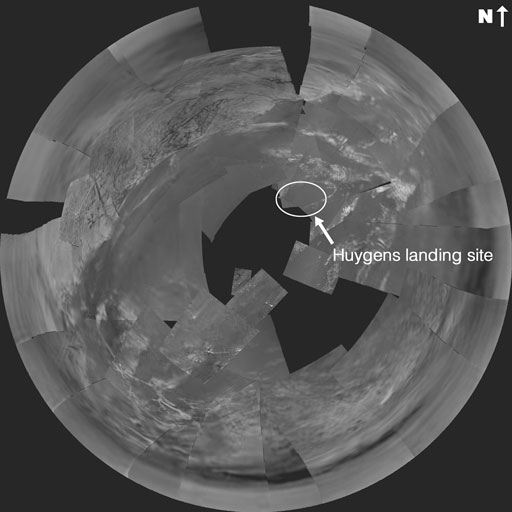
Three Kilometers Above Titan
Explanation: What did the Huygens probe see as it descended toward Saturn's Moon Titan? In January the robot Cassini spacecraft now orbiting Saturn released a probe through the dense cloud decks of one of the Solar System's most mysterious moons. Below the clouds, as it descended, the probe took images of the approaching surface as well as several images from the surface itself. Many of the images have now been digitally merged and scaled into the above perspective from 3,000 meters high. The above stereographic projection shows a 360-degree wide-angle view of the surface of Titan. The bright areas toward the top and left of the image are thought to be relatively high ground laced with drainage channels cut by rivers of methane. The bright shapes on the right are now hypothesized to be ridges of ice gravel. Huygen's landing site, labeled, appears to be on a type of dark dry lakebed, once fed by a large dark flow channel on the left. The Huygen's probe lasted an unexpectedly long three hours on Titan's harsh surface.
Credit: ESA, NASA, Descent Imager/Spectral Radiometer Team (LPL) -
Ale's Stones
Ale's Stones is a megalithic monument in Scania, from circa 500 BC, that is, the end of the Nordic Bronze Age and the beginning of the Pre-Roman Iron Age.
Ale's Stones, Scania, Sweden
Ale's Stones consist of a 67 metre long stone ship formed by 59 large pieces of sandstone, weighing up to 1.8 tons.
Inside the formation, remains of coal and human bones have been found and they have been dated to circa 1500 BP (i.e. circa 500 BC).
Speculations
Like many other megalithic monuments, speculations have been made about the significance of Ale's Stones. One of those attributed to Ale's Stones is that the structure had an astronomical purpose, based on the controversial interpretation that the stones have been positioned according to the 365 days of the year and the 24 hours of the day. Bob G. Lind is the main proponent of this theory, which is considered to be pseudoscience by established scholars. Professional astronomers and archaeologists believe that this is an incineration grave dating from circa 500BC. Folklores ascribe AleÂ’ stones to be King AleÂ’s grave.
Issue #86 -
Astronomy Picture of the Day
2005 May 19
X-Ray Stars in the Orion Nebula
Explanation: When our middle-aged Sun was just a few million years old it was thousands of times brighter in x-rays. In fact, it was likely similar to some of the stars found in this false-color x-ray composite of the Orion Nebula region from the Chandra Observatory. The image is centered on bright stars of the nebula's Trapezium star cluster, and while analyzing the Chandra data astronomers have now found examples of young, sun-like stars producing intense x-ray flares. It sounds dangerous, but the situation may actually favor the formation of hospitable planetary systems like our own. Energetic flares can produce turbulence in the planet-forming disks surrounding the stars - preventing rocky earth-like planets from spiraling uncomfortably close to and even falling into their active, young parent stars. About 1,500 light-years away, the Orion Nebula is the closest large stellar nursery. At that distance, this Chandra image spans about 10 light-years.
Credit: E.Feigelson & K.Getman (PSU) et al. CXC / NASA -
Stone ship
The Stone ship was a Gemanic burial custom, typical for Scandinavia with scattered examples in Northern Germany and along the coast of the Baltic States (where they are called devil ships). They are believed to have represented the actual burning ship in which the dead was sent out to the sea. Excavations have shown that they are usually from the latter part of the Nordic Bronze Age ca. 1000 BC - 500 BC (e.g. Gotland) or from the Germanic Iron Age, the Vendel Age and the Viking Age (e.g. Blekinge and Scania).
The stone ship at Anund's barrow
The stone ships are built from tighly or loosely fit slabs or stones. Sometimes they are of monumental proportions. In Sweden, the size varies from 67 metres (Ale's Stones) to only a few metres. The orientation varies. Inside, they can be cobbled or filled with stones, or have raised stones in the positions of masts. The illusion of being ships has often been reinforced by larger stones in the ends. Some have an oblique aft. Ship settings are often found on grave fields, but sometimes far from any other archaeological remains.
Prominent stone ships
-- Ale's Stones is a stone ship in southernmost Sweden. It is 67 metres long and 19 metres wide.
-- Stones of Askeberga (more images here) is Sweden's second largest stone ship measuring 55 metres in length. It is, however, the most remarkable one as it is made of 24 enormous boulders, weighing about 25 tonne each.
-- Anund's Mound. The double stone ship at Anund's mound has a total lenght of 100 metres and one of the ships is 25 metres wide. In the same area there are several smaller stone ships.
-- Stones of Blomsholm. The stone ship at Blomsholm near Strömstad in Bohuslän measures more than 40 m in length and consists of 49 large menhirs. The fore and the aft are about 4 meters tall. There are several other large megaliths in the area.
-- Tjelvar's Grave is according to legend the grave of Gotland's mythical discoverer Thjelvar, and it is dated to ca 750 BC.
Issue #87 -
Astronomy Picture of the Day
2005 May 20
Aurora Iowa
Explanation: Early last Sunday morning stars were not the only lights in Iowa skies. The northern lights also shone from the heavens, extending across the midwestern USA and other locations not often graced with auroral displays. The wide-ranging auroral activity was triggered as a coronal mass ejection - an energetic cloud of particles blasted outward from the Sun a few days earlier - collided with planet Earth's magnetosphere. Alerted to conditions ripe for aurora, photographer Stan Richard recorded this aparition over Saylorville Lake, near Des Moines. Bright planet Mars in the constellation Aquarius is above the horizon near the center of the eastward-looking view. While the colorful rays seem to end just above the water, they are actually at altitudes of 100 kilometers or more.
Credit & Copyright: Stan Richard -
Telescope
A telescope (from the Greek tele = 'far' and skopein = 'to look or see'; teleskopos = 'far-seeing') is an astronomical tool which gathers and focuses electromagnetic radiation. Telescopes increase the apparent angular size of objects, as well as their apparent brightness. Galileo Galilei is credited with being the first to use a telescope for astronomical purposes in 1609, calling it at first a perspicillum, and then using the terms telescopium in Latin and telescopio in Italian (from which the English word derives). Later, Johannes Kepler described the optics of lenses (see his books Astronomiae Pars Optica and Dioptrice), including a new kind of astronomical telescope with two convex lenses (a principle often called Kepler telescope).
50 cm refracting telescope at Nice Observatory.
Telescopes used for non-astronomical purposes are often referred to as theodolites, transits, spotting scopes, monoculars, binoculars, camera lenses, microscopes or spyglasses.
The word "telescope" usually refers to optical telescopes, but there are telescopes for most of the spectrum of electromagnetic radiation.
Radio telescopes are focused radio antennas, usually shaped like large dishes. The dish is sometimes constructed of a conductive wire mesh whose openings are smaller than a wavelength. Radio telescopes are often operated in pairs, or larger groups to synthesize large "virtual" apertures that are similar in size to the separation between the telescopes: see aperture synthesis. The current record is many times the width of the Earth, utilizing space-based VLBI telescopes such as the Japanese VSOP satellite. Aperture synthesis is now also being applied to optical telescopes using optical interferometers.
X-ray and gamma-ray telescopes have a problem because these rays go through most metals and glasses. They use ring-shaped "glancing" mirrors, made of heavy metals, that reflect the rays just a few degrees. The mirrors are usually a section of a rotated parabola.
Telescope mountings
A simple telescope mount is an altazimuth mount. It is similar to that of a surveying transit. A fork rotates in azimuth (in the horizontal plane), and bearings on the tips of the fork allow the telescope to vary in altitude (in a vertical plane). A dobsonian mount is a type of altazimuth mount which has proven to be very popular as it is simple and cheap to make.
The major problem with using an altazimuth for astronomy is that both axes must be continuously adjusted to compensate for the Earth's rotation. Even if this is done, by computer control, the image rotates at a rate that varies depending on the angle of the star from the celestial pole. The last effect especially makes an altazimuth mount impractical for long-exposure photography with small telescopes.
The preferred solution for astronomical telescopes is to tip the altazimuth mount so that the azimuth axis is parallel with the axis of the Earth's rotation; this is known as an equatorial mount.
Recently constructed large telescopes use a computer-controlled altazimuth mount, and for long exposures, they have (usually computer-controlled) variable-rate rotating erector prisms at the focus.
There are mountings even simpler than altazimuth, typically for specialised instruments. A few are: meridian transit (altitude only); fixed with movable plane mirror for solar observing; ball-and-socket (ancient and useless for astronomy).
Issue #88 -
Astronomy Picture of the Day
2005 May 21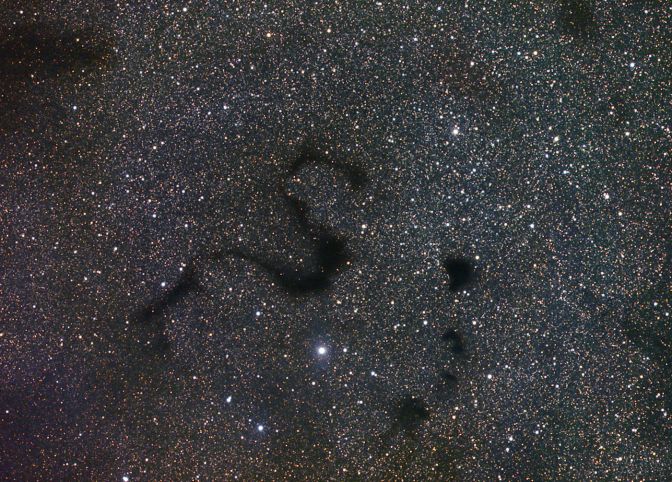
Snake in the Dark
Explanation: Dark nebulae snake across a gorgeous expanse of stars in this wide-field view toward the pronounceable constellation Ophiucus and the center of our Milky Way Galaxy. In fact, the central S-shape seen here is well known as the Snake Nebula. It is also listed as Barnard 72 (B72), one of 182 dark markings of the sky cataloged in the early 20th century by astronomer E. E. Barnard. Unlike bright emission nebulae and star clusters, Barnard's nebulae are interstellar dark clouds of obscuring gas and dust. Their shapes are visible in cosmic silhouette only because they lie in the foreground along the line of sight to rich star fields and glowing stellar nurseries near the plane of our Galaxy. Many of Barnard's dark nebulae are themselves likely sites of future star formation. Barnard 72 is a few light years across and about 650 light years away.
Credit & Copyright: Gary Stevens -
Telescope - Cont'd
Research telescopes
Most large research telescopes can operate as either a cassegrain telescope (longer focal length, and a narrower field with higher magnification) or newtonian telescope (brighter field). They have a pierced primary, a newtonian focus, and a spider to mount a variety of replaceable secondaries.
Harlan J. Smith Telescope at McDonald Observatory, Texas
A new era of telescope making was inaugurated by the MMT, a synthetic aperture composed of six segments synthesizing a mirror of 4.5 metres diameter. Its example was followed by the Keck telescopes, a synthetic-aperture 10 m telescope.
The current generation of telescopes being constructed have a primary mirror of between 6 and 8 meters in diameter (for ground-based telescopes). In this generation of telescopes, the mirror is usually very thin, and is kept in an optimal shape by an array of actuators (see active optics). This technology has driven new designs for future telescopes with diameters of 30, 50 and even 100 metres.
Initially the detector used in telescopes was the human eye. Later, the sensitized photographic plate took its place, and the spectrograph was introduced, allowing the gathering of spectral information. After the photographic plate, successive generations of electronic detectors, such as the charge-coupled device (CCDs), have been perfected, each with more sensitivity and resolution.
Current research telescopes have several instruments to choose from: imagers, of different spectral responses; spectrographs, useful in different regions of the spectrum; polarimeters, that detect light polarization, etc.
In recent years, some technologies to overcome the bad effect of atmosphere on ground-based telescopes were developed, with good results. See tip-tilt mirror and adaptive optics.
The phenomenon of optical diffraction sets a limit to the resolution and image quality that a telescope can achieve, which is the effective area of the Airy disc, which limits how close we may place two such discs. This absolute limit is called Sparrow's resolution limit. This limit depends on the wavelength of the studied light (so that the limit for red light comes much earlier than the limit for blue light) and on the diameter of the telescope mirror. This means that a telescope with a certain mirror diameter can resolve up to a certain limit at a certain wavelength, so if you want more resolution at that very wavelength, you have to build a wider mirror.
Famous optical telescopes
-- The Hubble Space Telescope is in orbit outside of the Earth's atmosphere to allow for observations not distorted by refraction, in this way they can be diffraction limited, and used for coverage in the ultraviolet (UV) and infrared.
Hubble Space Telescope as seen from the Space Shuttle Discovery.
-- The Very Large Telescope (VLT) is currently (2002) the record holder in size, with four telescopes each 8 metres in diameter. The four telescopes, belonging to ESO and located in the Atacama desert in Chile, can operate independently or together.
-- There are many plans for even larger telescopes. One of them is the Overwhelmingly Large Telescope or OWL, which is intended to have a single aperture of 100 metres in diameter.
-- The 200 inch (5.08 m) Hale telescope on Palomar Mountain is a conventional research telescope that was the largest for many years. It has a single borosilicate (Pyrex™) mirror that was famously difficult to construct. The mounting is also unique, an equatorial mount that is not a fork, yet permits the telescope to image near the north celestial pole.
-- The 100 inch (2.54 m) Hooker Telescope in the Mount Wilson Observatory was used by Edwin Hubble to discover galaxies, and the redshift. The mirror was made of green glass by Saint-Gobain. It is now part of a synthetic aperture array with several other Mt. Wilson telescopes, and is still useful for advanced research.
-- The 1.02 m Yerkes Telescope (in Wisconsin) is the largest aimable refractor in use.
-- The 0.76 m Nice refractor (in France) that became operational in 1888 was at that time the world's largest telescope. This was the last time the most powerful operationnal telescope in the world was located in Europe. It was outperformed one year later by the 0.91 m refractor at the Lick Observatory.
-- The largest refractor ever constructed was French. It was on display at the 1900 Paris Exposition. Its lens was stationary, prefigured so as to sag into the correct shape. The telescope was aimed by the aid of a Foucault sidérostat, which is a movable plane mirror with a 2 m diameter, mounted in a large cast-iron frame. The horizontal tube was 60 m long and the objective had 1.25 m in diameter. It was a failure.
Other meanings
-- There is a constellation called Telescopium.
-- Old-type telescopes were often made from tube sections that slid inside each other for easier stowage when not being used. As a result, anything that can lengthen and shorten in this way is said to be telescopic (adjective), and the process of shortening in this way is called telescoping (verb).
Issue #89 -
Astronomy Picture of the Day
2005 May 22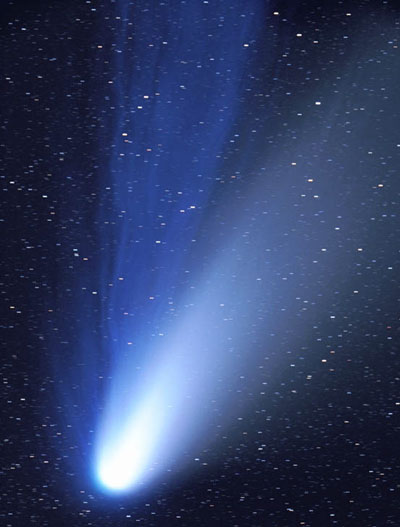
The Dust and Ion Tails of Comet Hale-Bopp
Explanation: In 1997, Comet Hale-Bopp's intrinsic brightness exceeded any comet since 1811. Since it peaked on the other side of the Earth's orbit, however, the comet appeared only brighter than any comet in two decades. Visible above are the two tails shed by Comet Hale-Bopp. The blue ion tail is composed of ionized gas molecules, of which carbon monoxide particularly glows blue when reacquiring electrons. This tail is created by the particles from the fast solar wind interacting with gas from the comet's head. The blue ion tail points directly away from the Sun. The light colored dust tail is created by bits of grit that have come off the comet's nucleus and are being pushed away by the pressure of light from the Sun. This tail points nearly away from the Sun. The above photograph was taken in March 1997.
Credit & Copyright: John Gleason (Celestial Images) -
Radio telescope
In contrast to an "ordinary" telescope, which produces visible light images, a radio telescope "sees" radio waves emitted by radio sources, typically by means of a large parabolic ("dish") antenna, or arrays of them. The first of these was the 9 m telescope constructed by Grote Reber in 1937. In the early 1950s the Cambridge Interferometer mapped the radio sky to produce the famous 2C and 3C surveys of radio sources. In the late 1950s and early 1960s the largest single-dish radio telescope in the world was the 76 metre telescope at Jodrell Bank, which became operational in 1957. This was just the latest of many radio telescopes constructed during the middle of the 20th Century, and has been surpassed by more modern telescopes and arrays of telescopes.
The Parkes 64 metre radio telescope in New South Wales, Australia (the bigger of the two shown).
The collecting area of the telescope is a 64-m diameter paraboloid (the dish). The surface is high precision aluminium millimetre wavepanels to a diameter of 17-m (for operation to 43 GHz), then perforated aluminium plate out to 45-m, and rectangular galvanised steel 5/16-inch mesh for the remainder of the surface. The aerial cabin, which houses feeds and receiver equipment, is supported by a tripod.
The Parkes Observatory is situated near Alectown, 25 kilometres north of the town of Parkes which is approximately 365 kilometres west of Sydney. The Observatory is part of the Australia Telescope National Facility (ATNF) a division of the Commonwealth Scientific and Industrial Research Organisation (CSIRO). The Parkes site contains a 64-metre RadioTelescope, an administration building with offices, workshops and library, an Observer's Quarters and Visitors Centre.
The largest individual radio telescope is the RATAN-600 (Russia) with 576 metre diameter of circular antenna (RATAN-600 description). The largest radio telescope in Europe is the 100 metre diameter antenna in Effelsberg, Germany, which also was the largest fully steerable telecope for 30 years until the Green Bank Telescope was opened in 2000. The largest radio telescope in the United States until 1998 was Ohio State University's The Big Ear. A typical size of the single antenna of a radio telescope is 25 metre, dozens of radio telescopes with comparable sizes are operated in radio observatories all over the world.
The best-known (although non-steerable) radio telescope probably is the Arecibo radio telescope located in Arecibo, Puerto Rico.
Another well-known radio telescope is the Very Large Array (VLA), in Socorro, New Mexico. This telescope consists of an interferometric array formed from several receivers. The largest exisiting radio telescope array is the GMRT. A larger array, the 'LOw Frequency ARray' is currently being constructed in western Europe, consisting of 25,000 small antennas over an area of several 100s of kilometres in diameter.
The Very Large Array at Socorro, New Mexico, USA. As with many radio telescopes, this is an interferometric array formed from many smaller telescopes.
The sub-field of astronomy related to observations made through radio telescopes is known as radio astronomy.
Many celestial objects, such as pulsars or active galaxies (like quasars), produce radio-frequency radiation and so are best "visible" or even only visible in the radio region of electromagnetic spectrum. By examining the frequency, power and timing of radio emissions from these objects, astronomers can improve our understanding of the Universe.
Radio telescopes are also occasionally involved in SETI and tracking space probes.
Issue #90 -
Astronomy Picture of the Day
2005 May 23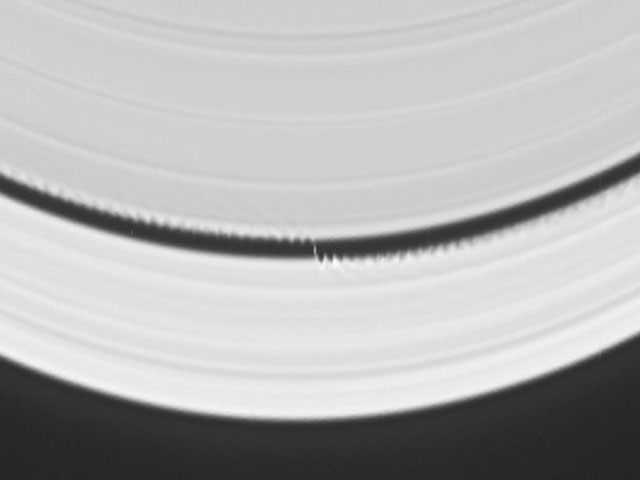
A Wave Maker Moon in Saturn's Rings
Explanation: What causes small waves in Saturn's rings? Observations of rings bordering the Keeler gap in Saturn's rings showed unusual waves. Such waves were first noticed last July and are shown above in clear detail. The picture is a digitally foreshortened image mosaic taken earlier this month by the robot Cassini spacecraft now orbiting Saturn. The rings, made of many small particles, were somehow not orbiting Saturn in their usual manner. Close inspection of the image shows the reason - a small moon is orbiting in the Keeler gap. The previously unknown moon is estimated to span about seven kilometers and appears to have the same brightness as nearby ring particles. The gravity of the small moon likely perturbs the orbits of ring particles that come near it, causing them to shimmer back and forth after the moon passes. Since inner particles orbit more quickly than outer particles, only the leading particles of the inner rings and the trailing particles of the outer rings show the wave effect.
Credit: Cassini Imaging Team, SSI, JPL, ESA, NASA -
Reflecting telescope
A reflecting telescope (reflector) is an optical telescope which uses mirrors, rather than lenses, to reflect light. The British scientist Sir Isaac Newton designed the first reflector circa 1670. He designed the reflector in order to solve the problem of chromatic aberration, a serious degradation in all refracting telescopes before the perfection of achromatic lenses. The traditional two-mirrored reflector is known as a Newtonian reflector.
Ritchey 24" reflecting telescope
While the Newtonian focus design still used in amateur astronomy, professionals now tend to use prime focus, Cassegrain focus, and coudé focus designs. By 2001, there were at least 49 reflectors with primary mirrors having diameters of 2 m+.
Technical considerations
The primary mirror is the reflector telescope's basic optical element and creates an image at the focal plane. The distance from the mirror to the focal plane is called the focal length. Film or a digital sensor may be located here to record the image, or an eyepiece for visual observation.
Reflector mirrors eliminate chromatic aberration but still contain other types of aberrations. Expensive telescopes will have additional optical elements to correct some of these aberrations:
-- spherical aberration when a non-parabolic mirror is used (the image plane is not flat)
-- coma
-- distortion over the field of view
Nearly all large research-grade astronomical telescopes are reflectors. There are several reasons for this:
-- In a lens the entire volume of material has to be free of imperfection and inhomogeneities, whereas in a mirror, only one surface has to be perfectly polished.
-- Light of different wavelengths travels through a medium other than vacuum at different speeds. This causes chromatic aberration in uncorrected lenses and creating an aberration-free large lens is a costly process. A mirror can eliminate this problem entirely.
-- There are structural problems involved in manufacturing and manipulating large-aperture lenses. A lens can only be held by its edge, which means that the sag due to gravity can be sufficient to distort the image. In contrast, a mirror can be supported by the whole side opposite its reflecting face.
Reflecting telescope designs
Schmidt camera
The Schmidt camera, invented by Bernhard Schmidt, is not technically a telescope since the light path does not exit to an eyepiece. Therefore it is strictly a camera, with a photographic plate, film or a CCD placed at the prime focus. The Schmidt camera corrects for spherical aberration by placing a correcting lens at the center of curvature of the mirror. The corrector, which is thicker in the middle and the edges, corrects the light paths so that the outer and inner parts of the mirror focus at the same distance. A simpler lensless Schmidt can be made by placing an aperture stop at the center of curvature, stopping the aperture to f/8 or longer. This degrades the light gathering ability of the telescope but produces a sharp image while preserving the wide field of the shorter focal length mirror. The 48" telescope at Palomar Observatory is actually a Schmidt camera.
Newtonian focus
The Newtonian usually has a paraboloid primary mirror but for small apertures, say 12 cm or less, if the focal ratio if f/8 or longer a spherical primary mirror is sufficient for high visual resolution. A flat secondary mirror reflects the light to a focal plane at the side of the top of the telescope tube. It is one of the simplest and least expensive designs for a given size of primary, and is popular with amateurs as a home-build project. Since the light path is unfolded, the tube is often quite long and heavy. The difficulty in making the paraboloid mirror with accuracy is proportional to its diameter. Amateurs often begin by producing a mirror of modest size (up to six inches/15 cm diameter) and progressing to larger sizes once they have some experience. Some amateurs produce a spherical mirror, and live with the spherical aberration, which is acceptable in longer focal length mirrors, where the difference between a spheroid and a paraboloid is very small. However, amateurs can grind and polish diffraction-limited paraboloid mirrors of substantial size (over 12 inches/300 mm diameter). If straight spider vanes support the secondary mirror they cause diffractive effects making stars appear to "flare" in four or six directions--curved spiders can markedly reduce flares.
A Newtonian telescope placed on a simple altazimuth mounting is known as a Dobsonian. This variant (popularized by John Dobson in the 1970s) allows for a large primary mirror in a relatively cheap and lightweight telescope which is simple to build and use. For photographic use, an equatorial mount is needed, in which the telescope rotates around an axis parallel to the Earth's axis, allowing it to follow the apparent motion of stars.
Issue #91 -
Astronomy Picture of the Day
2005 May 24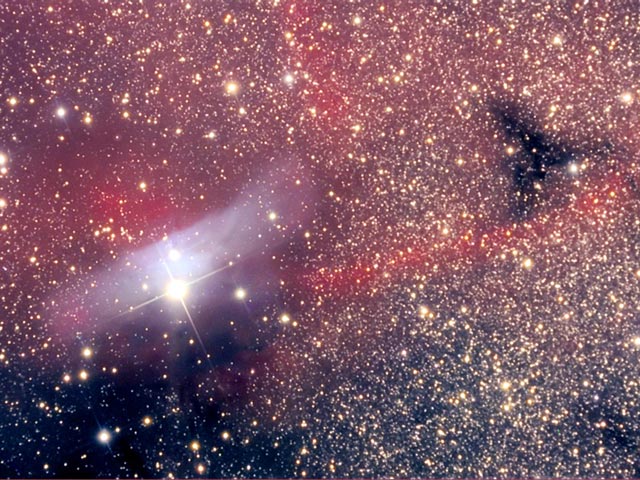
Swirls and Stars in IC 4678
Explanation: Swirls of gas and dust enrich this little observed starfield toward the constellation of Sagittarius. Just to the side of the more often photographed Lagoon Nebula (M8) and the Trifid Nebula (M20) lies this busy patch of sky dubbed IC 4678. Prominent in the above image are large emission nebulas of red glowing gas highlighted by unusually bright red filaments. On the left, a band of thin dust preferentially reflects the blue light of a bright star creating a small reflection nebula. On the right and across the bottom, swaths of thicker dust appear as dark absorption nebulas, blocking the light from stars farther in the distance. IC 4678 spans about 25 light years and lies about 5,000 light years distant.
Credit & Copyright: Ken Siarkiewicz & Adam Block, NOAO, AURA, NSF -
Reflecting telescope - Cont'd
Reflecting telescope designs - Cont'd
Cassegrain focus
The Cassegrain has a parabolic primary mirror, and a hyperbolic secondary mirror that reflects the light back down through a hole in the primary. Folding the optics makes this a compact design. On smaller telescopes, and camera lenses, the secondary is often mounted on an optically-flat, optically-clear glass plate that closes the telescope tube. This support eliminates the "star-shaped" diffraction effects caused by a straight-vaned support spider. The closed tube stays clean, and the primary is protected, at some loss of light-gathering power.
Light path in a Cassegrain
Ritchey-Chrétien
The Ritchey-Chrétien is a specialized Cassegrain reflector which has two hyperbolic mirrors (instead of a parabolic primary). It is free of coma and spherical aberration at a flat focal plane, making it well suited for wide field and photographic observations. Almost every professional reflector telescope in the world is of the Ritchey-Chrétien design. It was invented by George Willis Ritchey and Henri Chrétien in the early 1910s.
One exception to the supremacy of Ritchey-Chrétien telescopes for professional use are Schmidt cameras. These instruments have a very wide field in sharp focus, about 30 times greater than Ritchey-Chrétien, with the drawbacks that the focus is inaccessible, making them usable only as cameras, and to Cassegrain, they have their physical length at least twice their focal length. Their optical performance comes from the use of a spherical mirror which reintroduces the spherical and field curvature aberrations, but avoids all the others. The spherical aberration is overcome by using a corrector lens in front of the telescope at the radius of the curvature of the mirror. The field curvature are compensated with a film-holder that stretches the film into a mild spherical shape.
Schmidt-Cassegrain
The Schmidt-Cassegrain is a classic wide-field telescope. The first optical element is a Schmidt corrector plate. The plate is figured by placing a vacuum on one side, and grinding the exact correction required to correct the spherical aberration caused by the primary mirror. Thirty inch Schmidt-Cassegrains are used for sky surveys at astronomical observatories and satellite tracking stations.
Maksutov
The Maksutov, invented by Dmitri Maksutov, is similar to the Cassegrain. It starts with an optically transparent corrector lens that is a section of a hollow sphere. It has a spherical primary mirror, and a spherical secondary that is often just a mirrored section of the corrector lens. Maksutovs are mechanically simpler than small Cassegrains, have a closed tube and all-spherical optics. Maksutovs have a narrower field of view than Schmidt-Cassegrains and are generally heavier as well. However, their small secondary mirror gives them better resolution than a Schmidt-Cassegrain.
Light path in a Maksutov
One very popular luxury telescope design was the Questar. It ran a "finder" scope and the main scope to the same eyepiece. It had a 9cm clear-aperture Maksutov reflector as the main telescope. The finder was a 2.5 cm refractor. The focal plane of the reflector and refractor were the same (probably the refractor had a factory adjustment). A flat-mirror near the bottom reflected light to the finder's primary, and a movable mirror at the back of the larger 10-cm cassegrain's hole switched the optical path of the large telescope between the eyepiece and the camera attachment on the back. When the camera was engaged, the finder-scope was operational.
An unusual variant of the Cassegrain is the Schiefspiegler telescope ("skewed" or "oblique reflector"), which uses tilted mirrors to avoid the secondary mirror casting a shadow on the primary. However, while eliminating diffraction patterns this leads to several other aberrations that must be corrected.
Gregorian
The Gregorian telescope, invented by James Gregory, employs a concave, not convex, secondary mirror and in this way achieves a upright image, useful for terrestial observations. Whereas the design has largely fallen in disfavour, some small spotting scopes are still built this way.
Focal planes
Prime focus
In a prime focus design, the observer sits inside the telescope, at the focal point of the reflected light. In the past this would be the astronomer himself, but nowadays CCD cameras are used.
Radio telescopes often have a prime focus design. The mirror is replaced by a metal surface for reflecting radio waves, and the observer is an antenna.
Coudé focus
The Coudé design is similar to the Cassegrain except no hole is drilled in the primary mirror; instead, a third mirror reflects the light to the side, and further optics deliver the light to a fixed focus point that does not move as the telescope is reoriented. This design is often used on large observatory telescopes, as it allows heavy observation equipment, such as spectrographs, to be more easily used.
Issue #92 -
Astronomy Picture of the Day
2005 May 25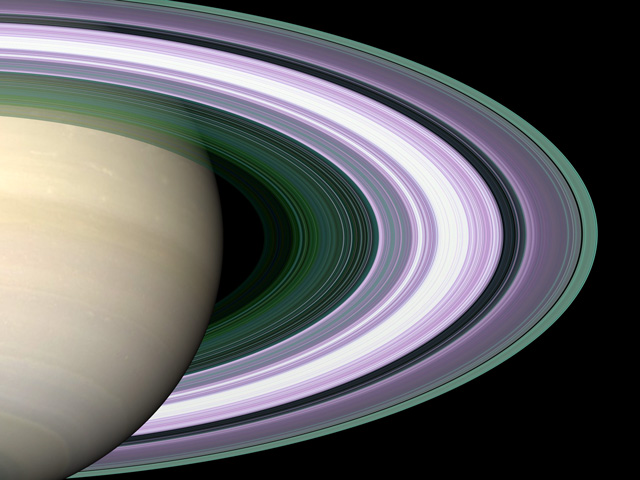
Particle Sizes in Saturn's Rings
Explanation: What size particles compose Saturn's rings? To help find out, the robot Cassini spacecraft now orbiting Saturn broadcast radio waves of three different wavelengths right through the rings to Earth earlier this month. The experiment was sensitive to ring particle sizes because ring particles much larger than a broadcast radio wavelength will reflect those radio waves away. Three different wavelengths were used: approximately 1 centimeter, 3.5 centimeters, and 13 centimeters. The results are coded into the above false-color digitally reconstructed image. In the above image, the color purple indicates regions populated predominantly by ring particles larger than 5 centimeters, while the color green indicates regions with a significant population of small ring particles less than even 1 centimeter. The white center of Saturn's B-ring indicates that the density of ring particles was too high to make a good determination. Other radio observations indicate that some ring particles can be as large as several meters across. The impressive nature and clarity of the above sharp image may help determine clues about the origin of Saturn's beautiful but enigmatic ring system.
Credit: RSS, JPL, ESA, NASA -
Refracting telescope
A refracting or refractor telescope is a type of optical telescope which refracts light at each end using lenses. This refraction causes parallel light rays to converge at a focal point; while those which were not parallel converge upon a focal plane. This can enable a user to view a distant object as if it were brighter, clearer, and/or larger. These are similar to microscopes. The monocular is a type of refractor. A typical refractor has two lenses, an objective lens and an eyepiece lens. The objective lens has two pieces of glass (with different densities), "crown" and "flint glass". Each side of each piece is ground and polished, and then the two pieces are glued together. The curvatures are designed to cancel (limit?) chromatic and spherical aberration.
The 50 cm refractor at Nice Observatory.
Technical difficulties
While initially the most common type of telescope, these are today used primarily by amateur astronomers and solar astronomers, and have been supplanted in professional night-time astronomy by reflecting telescopes. However, some relatively small instruments with 100-150 mm objective lenses regularly produce astrophotography that rivals images created by professionals as recently as 20 years ago using what were then the largest telescopes on Earth. Vacuum solar telescopes such as the Swedish Solar Telescope often use the vacuum entrance window as a lens, and are thus refractor telescopes. The vacuum solar telescope design has produced the highest resolution images of the Sun currently available.
20 inch refractor at the Observatories at Chabot Space and Science Center in Oakland, California.
Refractors are criticized for their relatively high-degree of chromatic and spherical aberration. There is also the problem of lens sagging, a result of gravity affecting glass. There is a further problem of mis-refraction; caused by air bubbles trapped within the lenses. In addition, glass is opaque to certain wavelengths, and even visible light is dimmed when it passes through glass. Many of these problems are avoided by using reflecting telescopes.
8 inch refractor at the Observatories at Chabot Space and Science Center in Oakland, California.
Notable refracting telescopes
-- Yerkes Observatory (102 cm)
-- Swedish Solar Telescope (100 cm)
-- Lick Observatory (91 cm)
-- Paris Observatory (83 cm + 62 cm)
-- Nice Observatory (76 cm)
Issue #93



